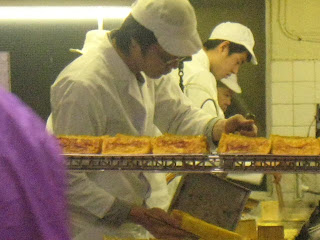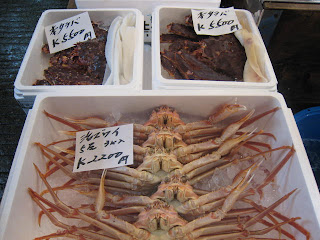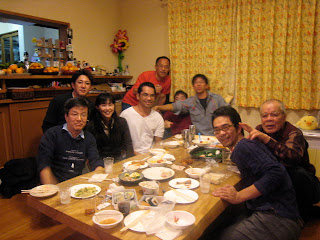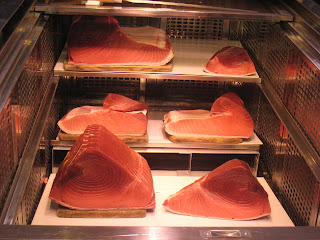Thursday, January 31, 2008
Back in Hawaii......
I finally have internet! After a week or so I finally managed to settle down in Hawaii after returning from Japan. It seems almost surreal being able to live and work in Japan. If you decide that you would like to travel to Japan and work there, its not as easy as it seems. Asides from the issue of getting a visa to work there, majority of the japanese people don't even speak english so knowing how to speak japanese is a must. Fortunately, my wife is japanese and I can speak the language. If getting a visa is no problem and you can speak japanese and you are pursuing a job in a patisserie or boulangerie you better be damn good at what you do because these people whom hold much pride in their work will expect much from you as a foreigner. If you can hang in with these people, the bright side is that there are many jobs available for patissiers and boulangiers in Japan. Here is a good website for those looking for a job in Japan http://www.gourmetcaree-tokyo.com/index.html . It has listings for all kinds of kitchen work. Just look in the patissier section.
Tuesday, January 22, 2008
Warm Sponges
I have decided to move my recipes to my blogsite. It's easier to work with and it's free!
The type of oven that you are working with makes the biggest difference in the overall result of the quality of the pastry that you are making whether it's sponge mixtures, cakes, cheesecakes, or even cookies. The best ovens are deck ovens that are tile lined on the inside with temperature controls for both the top and the bottom heating elements and a vent control. Convection ovens move the heat around the pastry too fast. Before the proteins in the pastry begin to coagulate the the expansion of the air trapped within the pastry have already exceeded their limit. This leads to dry and crumbly sponges, cracked cheesecakes, and so on. If you are working with a convection oven set the fan on the lowest level and always rotate 3/4 into the baking time. Pastry is a science after all. If there is one book I could recommend it would be Harold Mcgee's On Food and Cooking. Read it.
On some of the recipe's, lg flour means (low gluten flour), mg flour (medium gluten flour), and hg flour (high gluten flour).
Check for daily updates and additions for recipes.
To prepare the genoise, crack the eggs in a clean stainless bowl and add the sugar. Mix immediately until thoroughly mixed. Never add the sugar, leave it, and do something else. The sugar will start coagulating with the yolk of the egg and then you would get lumps (coagulated eggs in your mix). Place over a double boiler while continously mixing until 43 deg. C./110 deg. F. You can do this over direct heat, you just have to be careful that you don't make scrambled eggs. Strain the mixture into a mixing bowl. Whip on high speed until the mixture triples in volume. You should be able to clearly see the trail of the whip. This takes some experience in knowing when the sponge is ready. Fold in the flour too early and the sponge will collapse.
Sift the dry ingredients. Fold into the sponge with a spatula or a plastic scraper. Always fold in one direction and make sure the flour is thorougly mixed before adding the butter or other liquids.
Melt the butter. If you are adding glucose and/or milk add to the butter once its melted and warm till lukewarm. Mix part of the sponge mix with the butter/butter mix with a whisk and then fold into the mix. Pour into prepared pans and bake. Japanese genoise recipes have glucose and milk which creates a whole different texture to the genoise. It collapses the sponge a bit yet, creates a moist soft texture to the genoise.
Oven temp. for rings:
top/180 deg. C. bottom/170 deg. C.
For sheets:
top/220 deg. C. bottom/200 deg. C.
Convection for rings:
170 deg. C.
Convection for sheets:
180 deg. C.
Sift the dry ingredients. Fold into the sponge with a spatula or a plastic scraper. Always fold in one direction and make sure the flour is thorougly mixed before adding the butter or other liquids.
Melt the butter. If you are adding glucose and/or milk add to the butter once its melted and warm till lukewarm. Mix part of the sponge mix with the butter/butter mix with a whisk and then fold into the mix. Pour into prepared pans and bake. Japanese genoise recipes have glucose and milk which creates a whole different texture to the genoise. It collapses the sponge a bit yet, creates a moist soft texture to the genoise.
Oven temp. for rings:
top/180 deg. C. bottom/170 deg. C.
For sheets:
top/220 deg. C. bottom/200 deg. C.
Convection for rings:
170 deg. C.
Convection for sheets:
180 deg. C.
| Warm Sponge | |||
| Genoise: | 1-8" | Chocolate Genoise: | 1-8" |
| egg | 3 pc. | eggs | 3 pc. |
| sugar | 100 g. | sugar | 100 g. |
| flour | 100 g. | flour | 80 g. |
| butter | 20 g. | cocoa | 20 g. |
| butter | 20 g. | ||
| Sand Mixture | Chocolate Sand Mixture | ||
| egg | 300 g. | egg | 300 g. |
| sugar | 200 g. | sugar | 210 g. |
| flour | 180 g. | flour | 160 g. |
| cornstarch | 20 g. | cocoa | 20 g. |
| vanilla | 5 g. | cornstarch | 20 g. |
| butter | 150 g. | vanilla | 5 g. |
| butter | 50 g. | ||
| Mocha Genoise: | 1-9" | Vienna Mixture | |
| eggs | 4 pc. | egg | 300 g. |
| sugar | 120 g. | sugar | 200 g. |
| flour | 100 g. | flour | 200 g. |
| butter | 30 g. | butter | 150 g. |
| coffee powder | 10 g. | ||
| Hazelnut Sponge: | 1-8" | Almond Sponge with Butter: | 1-8" |
| eggs | 3 pc. | eggs | 3 pc. |
| sugar | 120 g. | sugar | 90 g. |
| flour | 90 g. | flour | 75 g. |
| hazelnut flour | 90 g. | almond flour | 45 g. |
| butter | 75 g. | butter | 25 g. |
| Genoise D'Amande (PH) | Genoise (Japan) | ||
| almond paste 50% | 60 g. | egg | 3 pc. |
| sugar | 50 g. | sugar | 100 g. |
| yolks | 33 g. | flour | 100 g. |
| eggs | 150 g. | butter | 20 g. |
| bread flour | 100 g. | glucose | 5 g. |
| melted butter | 350 g. | milk | 28 ml. |
| Genoise (Japan) II | 2-8cm. | Genoise (Japan) PP | |
| eggs | 294 g. | egg | 1215 g. |
| sugar | 170 g. | yolk | 135 g. |
| honey | 16 g. | sugar | 810 g. |
| glucose | 16 g. | lg flour | 810 g. |
| lg flour | 170 g. | milk | 162 g. |
| butter | 23 g. | butter | 162 g. |
| milk | 40 g. |
Saturday, January 19, 2008
Wednesday, January 16, 2008
Shibuya....
Yokohama....
Monday, January 14, 2008
Saturday, January 5, 2008
築地(Tsukiji Market)....
After 1 year I finally got around to going to Tsukiji. It was impressive to say the least. We got there around 9am. I didn't want to go to early and get caught among a mass of people. Yet, it was still busy at that time. I actually managed to do my shopping for dinner, and then some. We ended picking up tamagoyaki(my son's favorite), freshly shaved katsuoboshi, fresh wasabi, chutoro, and some fresh lobsters(the only place that you can actually find fresh lobsters in Japan).
Tsujiki temple
 Tamago yaki
Tamago yaki
 Freshly shaved katsuoboshi
Freshly shaved katsuoboshi Fresh Wasabi
Fresh Wasabi You gotta watch out for these guys driving around in these carts especially if you bring kids here.
You gotta watch out for these guys driving around in these carts especially if you bring kids here. 
 Preparing unagi
Preparing unagi Shucking clams
Shucking clams あわび (Abalone)
あわび (Abalone) Freshly cut maguro for sale
Freshly cut maguro for sale Assorted fresh crab
Assorted fresh crab たこ (octopus)
たこ (octopus) I actually had the chance to watch them cut up a whole tuna which was somewhat なつかしい. My first duties, when I started as a kitchen apprentice, was working in the butchery at the Guam Hilton. There we would actually get whole fish like this and have to cut and prepare the fish for cooking. Yet, we didn't have that 1.5 meter katana-like knife that they had to disect that fish which I thought was pretty cool. I'm sure there must be a name for that knife.
I actually had the chance to watch them cut up a whole tuna which was somewhat なつかしい. My first duties, when I started as a kitchen apprentice, was working in the butchery at the Guam Hilton. There we would actually get whole fish like this and have to cut and prepare the fish for cooking. Yet, we didn't have that 1.5 meter katana-like knife that they had to disect that fish which I thought was pretty cool. I'm sure there must be a name for that knife.Thursday, January 3, 2008
Where's the beef........
There is a big difference in the quality of beef that you find in your local japanese grocery stores here vs the beef that you find in american grocery stores. Japanese have a knack in perfecting the art of growing not only exceptional fruits and vegetables but also, producing the best quality beef in the world. We got this rib eye cut at a local grocery store at $42 a pound. If you think that's expensive, expect to be putting out at least $150 for 100 g. of Matsuzaka beef. That's $684 a pound!


Subscribe to:
Comments (Atom)
















































